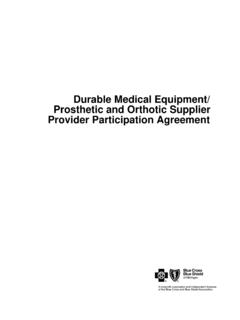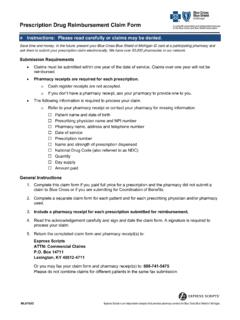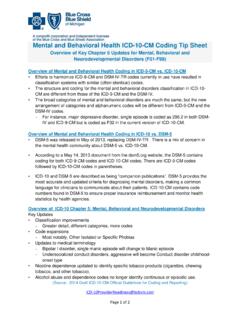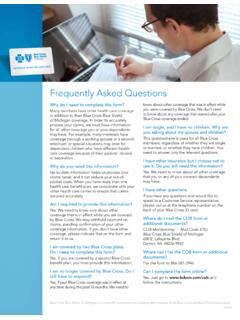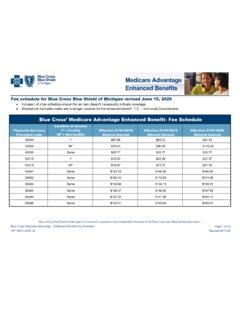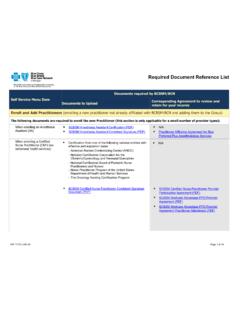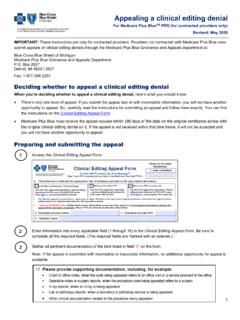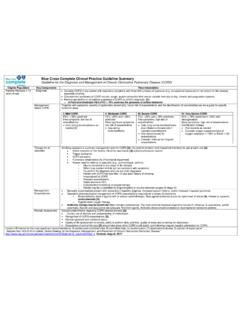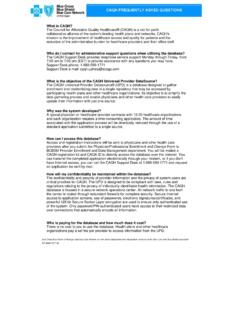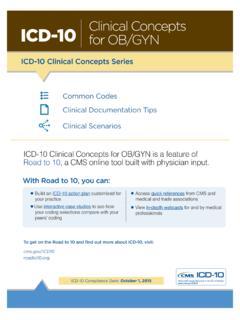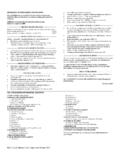Transcription of Pathology ICD-10-CM Coding Tip Sheet - Blue Cross Blue ...
1 1 Pathology ICD-10-CM Coding Tip Sheet Overview of Key Chapter Updates for Pathology and Top 25 codes Chapter 2 Neoplasms (C00-D49) Classification improvements Code expansions Significant expansions or revisions related to: - Identifying laterality for some of the neoplasm sites - Malignant neoplasm of male breast codes Chapter 3 Diseases of the Blood and Blood-forming Organs and certain Disorders involving the Immune Mechanism (D50-D89) Code expansions Updates to medical terminology Anemia is the most common condition included in this chapter. The use of specific terminology is important in applying codes for this condition. Procedural complications affecting the spleen are included in Chapter 3 of ICD-10-CM . Chapter 4 Endocrine, Nutritional and Metabolic Diseases (E00-E99) ICD-10-CM diabetes mellitus codes are now combination codes that include the type of diabetes (1 or 2), the body system affected and complications affecting the body system.
2 Use as many codes within a particular category as necessary to describe all of the complications of the disease. Diabetes mellitus (E08-E13) is no longer classified as controlled or uncontrolled in ICD-10-CM . With ICD-10-CM ,there are five category codes for diabetes mellitus: - E08 Diabetes mellitus due to underlying conditions - E09 Drug or chemical-induced diabetes mellitus - E10 Type 1 diabetes mellitus - E11 Type 2 diabetes mellitus - E13 Other specified diabetes mellitus Overweight and obesity codes: - The classification for overweight and obesity has been expanded in ICD-10-CM to include: Obesity due to excess calories Morbid (severe) obesity due to excess calories Drug-induced obesity Morbid (severe) obesity due to alveolar hypoventilation-overweight Additional code (Z68 category) is used to identify the body mass index, if known.
3 Chapter 5 Mental, Behavioral and Neurodevelopmental Disorders (F01-F99) Classification improvements (different categories) Code expansions: - Most notably, other isolated or specific phobias Updates to medical terminology: - Bipolar I disorder, single manic episode will change to manic episode. 2 - Undersocialized conduct disorders, aggressive will become conduct disorder childhood-onset type. Nicotine dependence will be updated to identify specific tobacco products (cigarettes, chewing tobacco and other tobacco). Chapter 6 Diseases of the Nervous System (G00-G99) ICD-10-CM devotes Chapter 6 to diseased of the nervous system. The sense organs (eye/adnexa and ear/mastoid processes) have their own chapters in ICD-10-CM . Classification improvements (significant changes to sleep disorders).
4 Code expansions (for example, Alzheimer s and headaches). Updates to medical terminology (epilepsy, seizures). Codes for transient ischemic attack are now included in the nervous system chapter. Codes for migraine have been expanded to fifth and sixth characters to indicate if the migraine is intractable and to provide additional specificity within the code description. Chapter 9 Diseases of the Circulatory System (I00-I99) A new category has been added for Coding a subsequent acute myocardial infarction, which is an MI that occurs within 28 days of a previous acute MI. The time frame for assigning the acute MI code is 28 days in ICD-10-CM . Terminology used to describe several cardiovascular conditions has been revised to reflect more current medical practice.
5 A major change is the classification of hypertension, which in ICD-9-CM was classified by type: - Benign, malignant or unspecified - That classification is not required in ICD-10-CM because there is only one code for hypertension in ICD-10; the code is I10- essential (primary) hypertension. Chapter 11 Diseases of the Digestive System (K00-K95) A number of new subcategories have been added to this chapter. Codes for Crohn s disease have been expanded to specify site, if a complication is present, and what that complication is. Some terminology changes and revisions to the classification of specific digestive conditions have occurred in ICD-10-CM as well: - The term hemorrhage is used when referring to ulcers. - The term bleeding is used when classifying gastritis, duodenitis, diverticulosis and diverticulitis.
6 Chapter 14 Diseases of the Genitourinary System (N00-N99) Procedural complications affecting the genitourinary system are included in Chapter 14. In some of the categories, specificity is based on the gender of the patient. Laterality is used to identify conditions under N60 category, benign mammary dysplasia. Chapter 18 Symptoms, Signs, and abnormal Clinical and Laboratory Findings (R00-R99) Many categories in this chapter could be designated as: Not otherwise specified Unknown etiology Transient There are codes to identify a patient s coma scale. There are a number of combination codes that identify both the definitive diagnosis and common symptoms of that diagnosis. 3 Chapter 21 Factors influencing Health Status and contact with Health Services (Z00-Z99) These codes are used in any healthcare setting.
7 Z codes may be used as either first listed (principal diagnosis code in the inpatient setting), or secondary code, depending on the circumstances of the encounter. Certain Z codes may only be used as first -listed or principal diagnosis in certain conditions-refer to Official Coding Guidelines for details. Aftercare code note: - In ICD-10-CM Aftercare Z codes are not used for aftercare of fractures. - For aftercare of a fracture, assign the acute fracture code with the 7th character extension of D for subsequent encounter. (Source: 2014 Draft ICD-10-CM Official Guidelines for Coding and Reporting) Examples of Coding Laterality Malignant neoplasm of central portion of right female breast Malignant neoplasm of central portion of left female breast Malignant neoplasm of central portion of unspecified female breast Malignant neoplasm of central portion of right male breast Malignant neoplasm of central portion of left male breast Malignant neoplasm of central portion of unspecified male breast The top 25 Pathology ICD-9 to ICD-10 mappings are found in the chart below.
8 Top 1-25 ICD-9 Description ICD-9 ICD-10 Description ICD-10 1 Screening for malignant neoplasms of cervix Encounter for screening for malignant neoplasm of cervix 2 Diabetes mellitus without mention of complication, type II or unspecified type, not stated as uncontrolled Type 2 diabetes mellitus without complications Other specified diabetes mellitus without complications 3 Other and unspecified hyperlipidemia Other hyperlipidemia Hyperlipidemia, unspecified 4 Unspecified essential hypertension I10 Essential (primary) hypertension 5 Other malaise and fatigue Postviral fatigue syndrome Neoplastic (malignant) related fatigue Weakness Other malaise Other fatigue 6 Anemia, unspecified Anemia, unspecified 7 Unspecified acquired hypothyroidism Hypothyroidism, unspecified 8 Routine gynecological examination Encounter for gynecological examination (general) (routine) with abnormal findings 9 Encounter for gynecological examination (general) (routine)
9 Without abnormal findings 10 Supervision of other normal pregnancy Encounter for supervision of other normal pregnancy, unspecified trimester Encounter for supervision of other normal pregnancy, first trimester Encounter for supervision of other normal pregnancy, second trimester Encounter for supervision of other normal pregnancy, third trimester 4 Top 1-25 ICD-9 Description ICD-9 ICD-10 Description ICD-10 Encounter for supervision of normal pregnancy, unspecified, unspecified trimester Encounter for supervision of normal pregnancy, unspecified, first trimester Encounter for supervision of normal pregnancy, unspecified, second trimester Encounter for supervision of normal pregnancy, unspecified, third trimester 11 Multiple myeloma, without mention of having achieved remission Multiple myeloma not having achieved remission 12 Other and unspecified nonspecific immunological findings Raised antibody titer Other specified abnormal immunological findings in serum Abnormal immunological finding in serum, unspecified 13 Malignant neoplasm of breast (female), unspecified Malignant neoplasm of unspecified site of right female breast Malignant neoplasm of unspecified site of unspecified female breast Malignant neoplasm of unspecified site of unspecified female breast 14 Benign essential hypertension I10 Essential (primary)
10 Hypertension 15 Urinary tract infection, site not specified Urinary tract infection, site not specified 16 Unspecified vitamin D deficiency Vitamin D deficiency, unspecified 17 Atrophic gastritis, without mention of hemorrhage Chronic superficial gastritis without bleeding Chronic atrophic gastritis without bleeding Unspecified chronic gastritis without bleeding 18 Abdominal pain, unspecified site Acute abdomen Unspecified abdominal pain 19 Pure hypercholesterolemia Pure hypercholesterolemia 20 Opioid type dependence, unspecified Opioid dependence, uncomplicated Opioid dependence with intoxication, uncomplicated Opioid dependence with intoxication delirium Opioid dependence with intoxication with perceptual disturbance Opioid dependence with intoxication, unspecified Opioid dependence with withdrawal Opioid dependence with opioid-induced mood disorder Opioid dependence with opioid-induced psychotic disorder with delusions Opioid dependence with opioid-induced psychotic disorder with hallucinations Opioid dependence with opioid-induced psychotic disorder, unspecified Opioid dependence with opioid-induced sexual dysfunction 5 The codes highlighted in orange indicate the individual ICD-9 code that is being mapped to one or many ICD-10 codes (Source of ICD-9-CM to ICD-10-CM mappings.)
